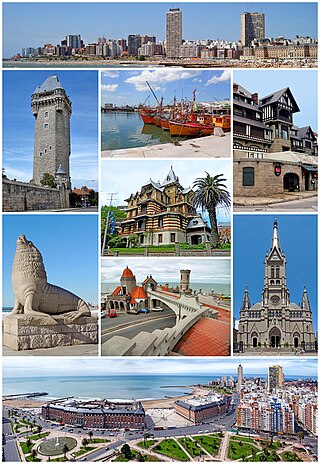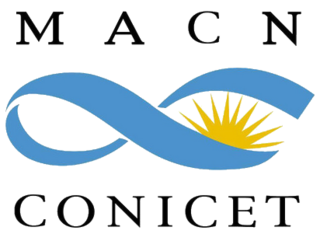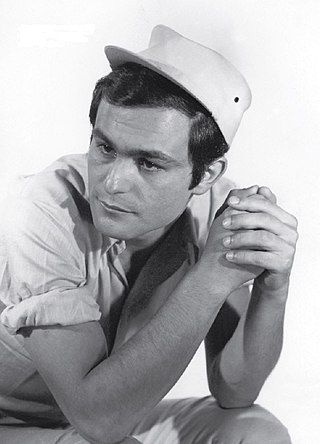
The Museum of the Sea was a museum of marine biology and aquarium in the seaside city of Mar del Plata, Argentina. The museum closed its doors in September 2012, after 12 years in operation. [1]

The Museum of the Sea was a museum of marine biology and aquarium in the seaside city of Mar del Plata, Argentina. The museum closed its doors in September 2012, after 12 years in operation. [1]
A gift box containing 15 seashells, and delivered to 18-year-old Benjamín Sisterna from his brother in 1932, created a lifelong fascination with sea shells and oceanography in the young man. Twenty-six trips around the world in sixty years resulted in a personal collection of over 30,000 shells, fossils and marine invertebrates, among other items.
Sisterna's death in 1995 left the collection to his heirs, who began work on the Museo del Mar, The Museum of the Sea, in Mar del Plata. Born in Santa Fe, Argentina, a city far from the Atlantic Ocean, Sisterna had lived in seaside mar del Plata for the last 40 years of his life.
Inaugurated on September 22, 2000, the museum was divided into four levels:
The museum closed its doors in 2012 due to the lack of official funds to continue its activities. [2] The multinational technological company Globant acquired the building in 2014. [3] One of its founders is Guibert Englebienne Jr, an entrepreneur born in Mar del Plata and whose family has deep roots in the city. [4] [5]

Mar del Plata is a city on the coast of the Atlantic Ocean, in Buenos Aires Province, Argentina. It is the seat of General Pueyrredón district. Mar del Plata is the second largest city in Buenos Aires Province. The name "Mar del Plata" is a shortening of "Mar del Rio de la Plata," and has the meaning of "sea of the Rio de la Plata basin" or "adjoining sea to the (River) Plate region". Mar del Plata is one of the major fishing ports and the biggest seaside beach resort in Argentina. With a population of 682.605 as per the 2022 census [INDEC], it is the 5th largest city in Argentina.

A maritime museum is a museum specializing in the display of objects relating to ships and travel on large bodies of water. A subcategory of maritime museums are naval museums, which focus on navies and the military use of the sea.

Aquarium Finisterrae is an aquarium located in A Coruña, Galicia, Spain. It is an interactive centre of the sciences of marine biology, oceanography. It advocates wildlife preservation, particularly the sea ecosystem and sea life.

A public aquarium or public water zoo is the aquatic counterpart of a zoo, which houses living aquatic animal and plant specimens for public viewing. Most public aquariums feature tanks larger than those kept by home aquarists, as well as smaller tanks.

The German Oceanographic Museum, also called the Museum for Oceanography and Fisheries, Aquarium, in the Hanseatic town of Stralsund, is a museum in which maritime and oceanographic exhibitions are displayed. It is the most visited museum in North Germany. In addition to the main museum building, the actual Oceanographic Museum, there are three other sites, the Ozeaneum, opened in July 2008, the Nautineum and the Natureum.

The Tigre Club stands on the banks of the Luján River, in Paseo Victorica, Tigre, near Buenos Aires, Argentina. The club, built next to the Tigre Hotel, was financed by Ernesto Tornquist and was designed by the architects Pablo Pater, Luis Dubois and the engineer Emilio Mitre ; it was opened on 13 January 1912. Like the hotel nearby opened in 1890, the Tigre Club soon became an important meeting place for the rich and famous. The elegant and luxurious building has two floors with mezzanines with large windows on almost all sides. The main saloon on the first floor has frescoes by the Spanish artist Julio Vila y Prades (1875-1930), the staircases are of marble and there are Venetian mirrors and French chandeliers.

The Natural History Museum of the University of Pisa, located in the city of Pisa in Tuscany, Italy, is a renowned institution dedicated to the study and display of natural history. The museum is home to one of the largest collections of cetacean skeletons in Europe, showcasing an impressive array of marine mammal specimens. In addition to its extensive cetacean holdings, the museum's oldest collections include seashells amassed by the Italian invertebrate scientist, Niccolò Gualtieri. Serving as both an educational and research institution, the museum invites visitors and scholars to explore the diversity and complexity of the natural world.

L'Oceanogràfic is an oceanarium situated on the dry Turia River bed to the southeast of the city center of Valencia, Spain, where different marine habitats are represented. It was designed by the architect Félix Candela and the structural engineers Alberto Domingo and Carlos Lázaro. It is integrated inside the cultural complex known as the Ciutat de les Arts i de les Ciències. It was opened on 14 February 2003.

The Bernardino Rivadavia Natural Sciences Argentine Museum is a public museum located in the Caballito section of Buenos Aires, Argentina.

The La Plata Museum is a natural history museum in La Plata, Argentina. It is part of the Facultad de Ciencias Naturales y Museo of the National University of La Plata.

Amancio Williams was an Argentine architect. He is among his country's leading exponents of modern architecture.

The Juan Carlos Castagnino Municipal Museum of Art is a museum of fine arts in Mar del Plata, Argentina. Its building, the Ortiz Basualdo Villa, is a National Monument of Argentina.

The Rodadero Sea Aquarium and Museum is a public aquarium and maritime museum located in the Inca Inca Cove off the Rodadero beach in Santa Marta, Colombia. It was opened in 1965 by Captain Francisco Ospina Navia. The aquarium is part of the National Network of Museums of Colombia and part of ACOPAZOA, the Colombian branch of the World Association of Zoos and Aquariums. Accessible mainly by motorboat, the aquarium has 13 pools with direct connection to the Caribbean Sea, and 15 glass aquaria that contain over 805 animals that include sharks, sea turtles, dolphins, sea lions, crustaceans, fishes and seabirds, 98% of which are native to the area.

The Mar del Plata style is a vernacular architectural style very popular during the decades between 1935 and 1950 mainly in the Argentine resort city of Mar del Plata, but extended to nearby coastal towns like Miramar and Necochea.

Havanna Holding S.A. is an Argentine manufacturer of food products, mostly known for its alfajores. The firm was founded in 1948 by Benjamín Sisterna, Demetrio Elíades, and Luis Sbaraglini and began its activities as a producer of alfajores in the city of Mar del Plata.

The Jurassic Museum of Asturias is located in the area of Rasa de San Telmo near the parish of Llastres in the municipality of Colunga, Asturias, Spain. Though the municipality of Ribadesella was initially proposed, Colunga was chosen for the building site in the late 1990s. Several landmarks are visible from the museum including the Bay of Biscay, the Sierra del Sueve, and the Picos de Europa. Strategically located over a mount on the Rasa de San Temo, the museum is in the midst the Jurassic Asturias.

The Museum of the Sea, opened in 1996, is a museum of natural history located in La Barra, in the department of Maldonado, Uruguay. It occupies about 2,300 m2 (25,000 sq ft) and is divided into four large halls, which are open to the public all year round.

The 100 Greatest Films of Argentine Cinema, also known as the Survey of Argentine cinema, are a series of opinion polls carried out to establish a list of the greatest films of Argentine cinema of all time. The original survey was carried out by the Museo del Cine Pablo Ducrós Hicken in the years 1977, 1984, 1991 and 2000. In 2022, a new edition was held, organized by the film magazines La vida útil, Taipei and La tierra quema, with support from INCAA, the Mar del Plata International Film Festival, the FestiFreak International Film Festival of La Plata, the Casa de la Cultura of General Roca and the Museo del Cine Pablo Ducrós Hicken.

The Casa del Puente is a house designed by the Argentine architect Amancio Williams in 1942 in the city of Mar del Plata, Argentina. The house is built over the course of a stream known as Las Chacras. It was intended to serve as the permanent residence of Williams father, Argentine musician and composer Alberto Williams. The project was originally known as Casa sobre el Arroyo. The house is listed among the most famous modernist buildings of the 20th century.